
Aquatic plants are plants that have adapted to living in aquatic environments. They are also referred to as hydrophytes or macrophytes to distinguish them from algae and other microphytes. A macrophyte is a plant that grows in or near water and is either emergent, submergent, or floating. In lakes and rivers, macrophytes provide cover for fish, substrate for aquatic invertebrates, produce oxygen, and act as food for some fish and wildlife.
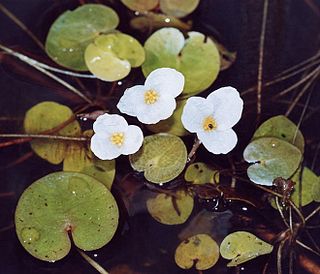
Hydrocharitaceae is a flowering plant family including 16 known genera with a total of ca 135 known species, that including a number of species of aquatic plant, for instance the tape-grasses, the well known Canadian waterweed, and frogbit.

Phrymaceae, also known as the lopseed family, is a small family of flowering plants in the order Lamiales. It has a nearly cosmopolitan distribution, but is concentrated in two centers of diversity, one in Australia, the other in western North America. Members of this family occur in diverse habitats, including deserts, river banks and mountains.

Hottonia palustris, also water violet or featherfoil, is an aquatic plant in the family Primulaceae.

Bacopa caroliniana is a flowering plant species.

Echinodorus cordifolius, the spade-leaf sword or creeping burhead, is a species of aquatic plants in the Alismatales. It is native to Mexico, the West Indies, Central America, South America and the southeastern United States.

Luronium natans is a species of aquatic plant commonly known as the floating water-plantain. It is the only recognized species in the genus Luronium, native to western and central Europe, from Spain to Britain to Norway east to Ukraine.

Limnophila sessiliflora, known as dwarf ambulia, ambulis, and Asian marshweed is a flowering plant in the family Plantaginaceae.
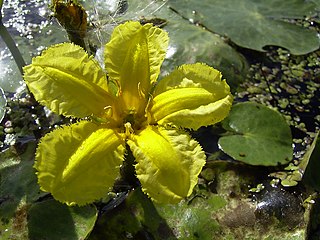
Nymphoides peltata is perennial, rooted aquatic plant with floating leaves of the family Menyanthaceae.
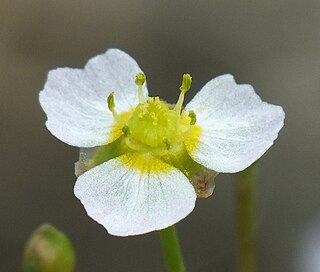
Alisma gramineum is a small aquatic plant in the water-plantain family. It has several common names including narrowleaf water-plantain, ribbonleaf water-plantain or ribbon-leaved water-plantain, and grass-leaved water-plantain. It grows in mud or submerged in shallow fresh or brackish water in marshy areas.

Callitriche stagnalis is a perennial aquatic vascular plant species. Also known as pond water-starwort, C. stagnalis, may thrive in a variety of aquatic and subaquatic habitats, specially those exhibiting slowly moving to non-moving water. Although C. stagnalis does not pose a threat to humans, its reproductive rate may pose a threat to native vegetation in areas where it has been introduced, as the resulting dense vegetative mats frequently out-compete native species.

Rubus repens(dewdrop, false violet, star violet, Robin runaway. French Canadian: dalibarde rampante) is a perennial plant in the rose family, native to eastern and central Canada and to the northeastern and north-central United States. It is part of the genus Rubus, which includes brambles, blackberries, and raspberries. Some authorities consider it the sole member of a separate genus, Dalibarda. It is fairly easily grown in shady locations in damp to wet, acidic soils, and is frequently used in wildflower and bog gardens as a ground-cover.

Myriophyllum verticillatum, the whorl-leaf watermilfoil or whorled water-milfoil, is a native to much of North America, North Africa, and Eurasia. It closely resembles another native milfoil, called northern water milfoil Whorled water milfoil is also easily confused with four types of invasive milfoils: Eurasian water milfoil, Variable water-milfoil, Parrot feather, and hybrid water milfoil.
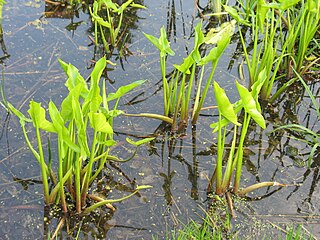
Peltandra virginica is a plant of the arum family known as green arrow arum and tuckahoe. It is widely distributed in wetlands in the eastern United States, as well as in Quebec, Ontario, and Cuba. It is common in central Florida including the Everglades and along the Gulf Coast. Its rhizomes are tolerant to low oxygen levels found in wetland soils. It can be found elsewhere in North America as an introduced species and often an invasive plant.

Polygala lewtonii is a rare species of flowering plant in the milkwort family known by the common name Lewton's polygala, or Lewton's milkwort. It is endemic to Florida in the United States, where it is limited to the central ridge of the peninsula. There are about 49 occurrences of the plant remaining. Most occurrences contain very few plants. The species is threatened by the loss and degradation of its habitat. This is a federally listed endangered species of the United States.
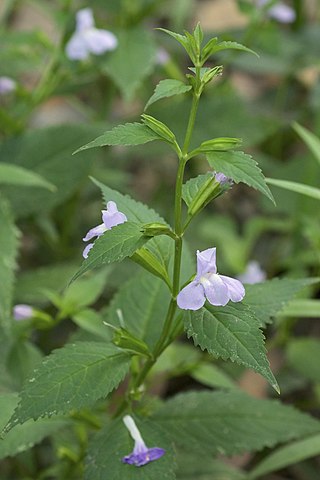
Mimulus alatus, the sharpwing monkeyflower, is an herbaceous eudicot perennial that has no floral scent. It is native to North America and its blooming season is from June to September. The flowering plant has green foliage and blue to violet flowers. It has a short life span compared to most other plants and a rapid growth rate. Like other monkey-flowers of the genus Mimulus, M. alatus grows best in wet to moist conditions and has a bilabiate corolla, meaning it is two-lipped. The arrangement of the upper and lower lip petals suggests a monkey’s face. The winged stems together with the monkey face give the plant its common name.
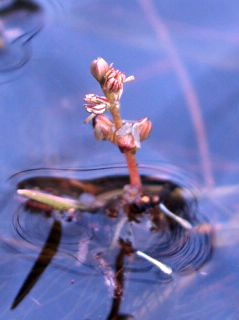
Myriophyllum alterniflorum, known as alternate water-milfoil or alternateflower watermilfoil, is a species of water-milfoil. It is native to Europe and Asia,has been introduced to North America and inhabits aquatic habitat, such as ponds and streams.

Erythranthe, the monkey-flowers and musk-flowers, is a diverse plant genus with more than 120 members in the family Phrymaceae. Erythranthe was originally described as a separate genus, then generally regarded as a section within the genus Mimulus, and recently returned to generic rank. Mimulus sect. Diplacus was segregated from Mimulus as a separate genus at the same time. Mimulus remains as a small genus of eastern North America and the Southern Hemisphere. Molecular data show Erythranthe and Diplacus to be distinct evolutionary lines that are distinct from Mimulus as strictly defined, although this nomenclature is controversial.
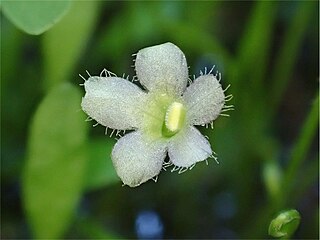
Glossostigma elatinoides, also known as small mud-mat, is a flowering plant in the family Phrymaceae and grows in eastern states of Australia. It is a small aquatic or terrestrial herb with mauve flowers.

Barclaya longifolia is a species of perennial aquatic plant native to the region of Indo-China to Northwest Peninsular Malaysia.




















